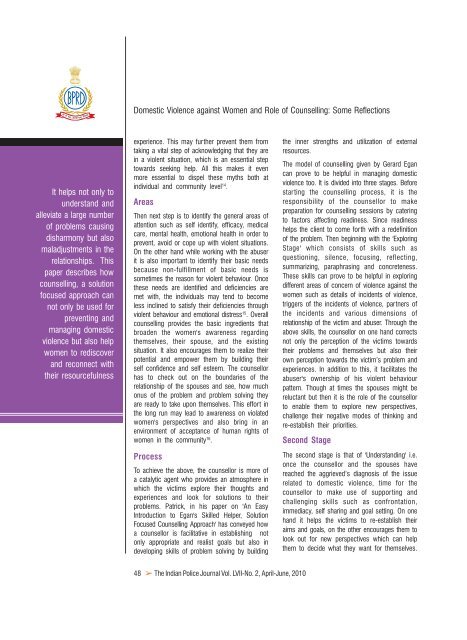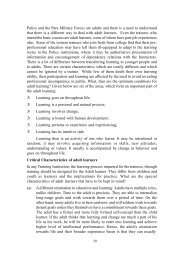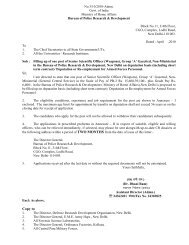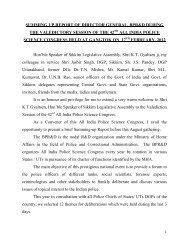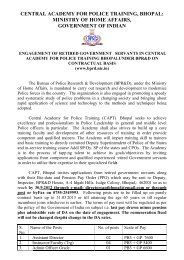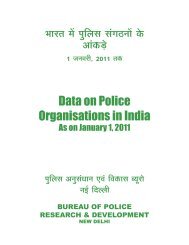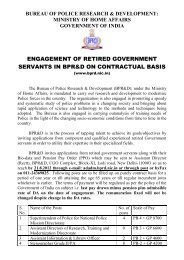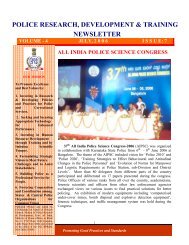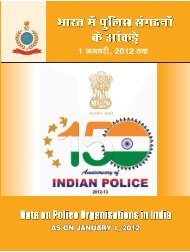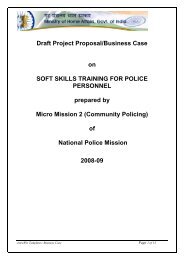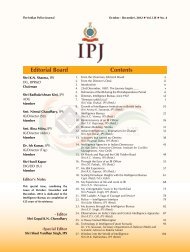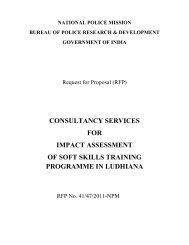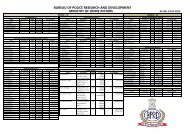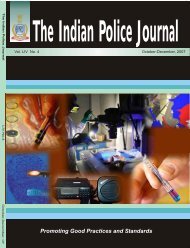April - June 2010 - Bureau of Police Research and Development
April - June 2010 - Bureau of Police Research and Development
April - June 2010 - Bureau of Police Research and Development
- No tags were found...
You also want an ePaper? Increase the reach of your titles
YUMPU automatically turns print PDFs into web optimized ePapers that Google loves.
Domestic Violence against Women <strong>and</strong> Role <strong>of</strong> Counselling: Some ReflectionsIt helps not only tounderst<strong>and</strong> <strong>and</strong>alleviate a large number<strong>of</strong> problems causingdisharmony but alsomaladjustments in therelationships. Thispaper describes howcounselling, a solutionfocused approach cannot only be used forpreventing <strong>and</strong>managing domesticviolence but also helpwomen to rediscover<strong>and</strong> reconnect withtheir resourcefulnessexperience. This may further prevent them fromtaking a vital step <strong>of</strong> acknowledging that they arein a violent situation, which is an essential steptowards seeking help. All this makes it evenmore essential to dispel these myths both atindividual <strong>and</strong> community level 14 .AreasThen next step is to identify the general areas <strong>of</strong>attention such as self identify, efficacy, medicalcare, mental health, emotional health in order toprevent, avoid or cope up with violent situations.On the other h<strong>and</strong> while working with the abuserit is also important to identify their basic needsbecause non-fulfillment <strong>of</strong> basic needs issometimes the reason for violent behaviour. Oncethese needs are identified <strong>and</strong> deficiencies aremet with, the individuals may tend to becomeless inclined to satisfy their deficiencies throughviolent behaviour <strong>and</strong> emotional distress 15 . Overallcounselling provides the basic ingredients thatbroaden the women's awareness regardingthemselves, their spouse, <strong>and</strong> the existingsituation. It also encourages them to realize theirpotential <strong>and</strong> empower them by building theirself confidence <strong>and</strong> self esteem. The counsellorhas to check out on the boundaries <strong>of</strong> therelationship <strong>of</strong> the spouses <strong>and</strong> see, how muchonus <strong>of</strong> the problem <strong>and</strong> problem solving theyare ready to take upon themselves. This effort inthe long run may lead to awareness on violatedwomen's perspectives <strong>and</strong> also bring in anenvironment <strong>of</strong> acceptance <strong>of</strong> human rights <strong>of</strong>women in the community 16 .ProcessTo achieve the above, the counsellor is more <strong>of</strong>a catalytic agent who provides an atmosphere inwhich the victims explore their thoughts <strong>and</strong>experiences <strong>and</strong> look for solutions to theirproblems. Patrick, in his paper on 'An EasyIntroduction to Egan's Skilled Helper, SolutionFocused Counselling Approach' has conveyed howa counsellor is facilitative in establishing notonly appropriate <strong>and</strong> realist goals but also indeveloping skills <strong>of</strong> problem solving by buildingthe inner strengths <strong>and</strong> utilization <strong>of</strong> externalresources.The model <strong>of</strong> counselling given by Gerard Egancan prove to be helpful in managing domesticviolence too. It is divided into three stages. Beforestarting the counselling process, it is theresponsibility <strong>of</strong> the counsellor to makepreparation for counselling sessions by cateringto factors affecting readiness. Since readinesshelps the client to come forth with a redefinition<strong>of</strong> the problem. Then beginning with the 'ExploringStage' which consists <strong>of</strong> skills such asquestioning, silence, focusing, reflecting,summarizing, paraphrasing <strong>and</strong> concreteness.These skills can prove to be helpful in exploringdifferent areas <strong>of</strong> concern <strong>of</strong> violence against thewomen such as details <strong>of</strong> incidents <strong>of</strong> violence,triggers <strong>of</strong> the incidents <strong>of</strong> violence, partners <strong>of</strong>the incidents <strong>and</strong> various dimensions <strong>of</strong>relationship <strong>of</strong> the victim <strong>and</strong> abuser. Through theabove skills, the counsellor on one h<strong>and</strong> correctsnot only the perception <strong>of</strong> the victims towardstheir problems <strong>and</strong> themselves but also theirown perception towards the victim’s problem <strong>and</strong>experiences. In addition to this, it facilitates theabuser's ownership <strong>of</strong> his violent behaviourpattern. Though at times the spouses might bereluctant but then it is the role <strong>of</strong> the counsellorto enable them to explore new perspectives,challenge their negative modes <strong>of</strong> thinking <strong>and</strong>re-establish their priorities.Second StageThe second stage is that <strong>of</strong> 'Underst<strong>and</strong>ing' i.e.once the counsellor <strong>and</strong> the spouses havereached the aggrieved’s diagnosis <strong>of</strong> the issuerelated to domestic violence, time for thecounsellor to make use <strong>of</strong> supporting <strong>and</strong>challenging skills such as confrontation,immediacy, self sharing <strong>and</strong> goal setting. On oneh<strong>and</strong> it helps the victims to re-establish theiraims <strong>and</strong> goals, on the other encourages them tolook out for new perspectives which can helpthem to decide what they want for themselves.48 ➢ The Indian <strong>Police</strong> Journal Vol. LVII-No. 2, <strong>April</strong>-<strong>June</strong>, <strong>2010</strong>


